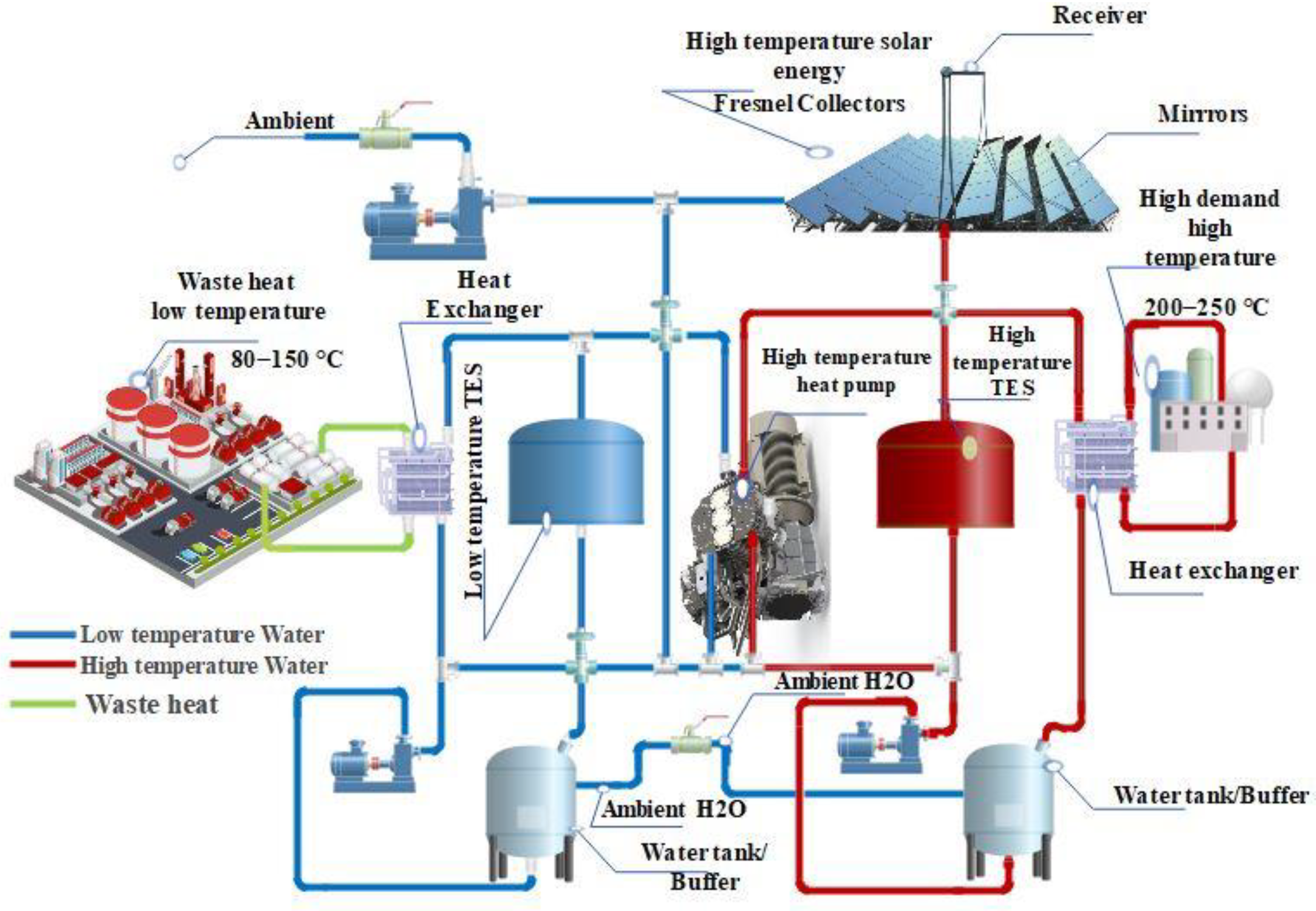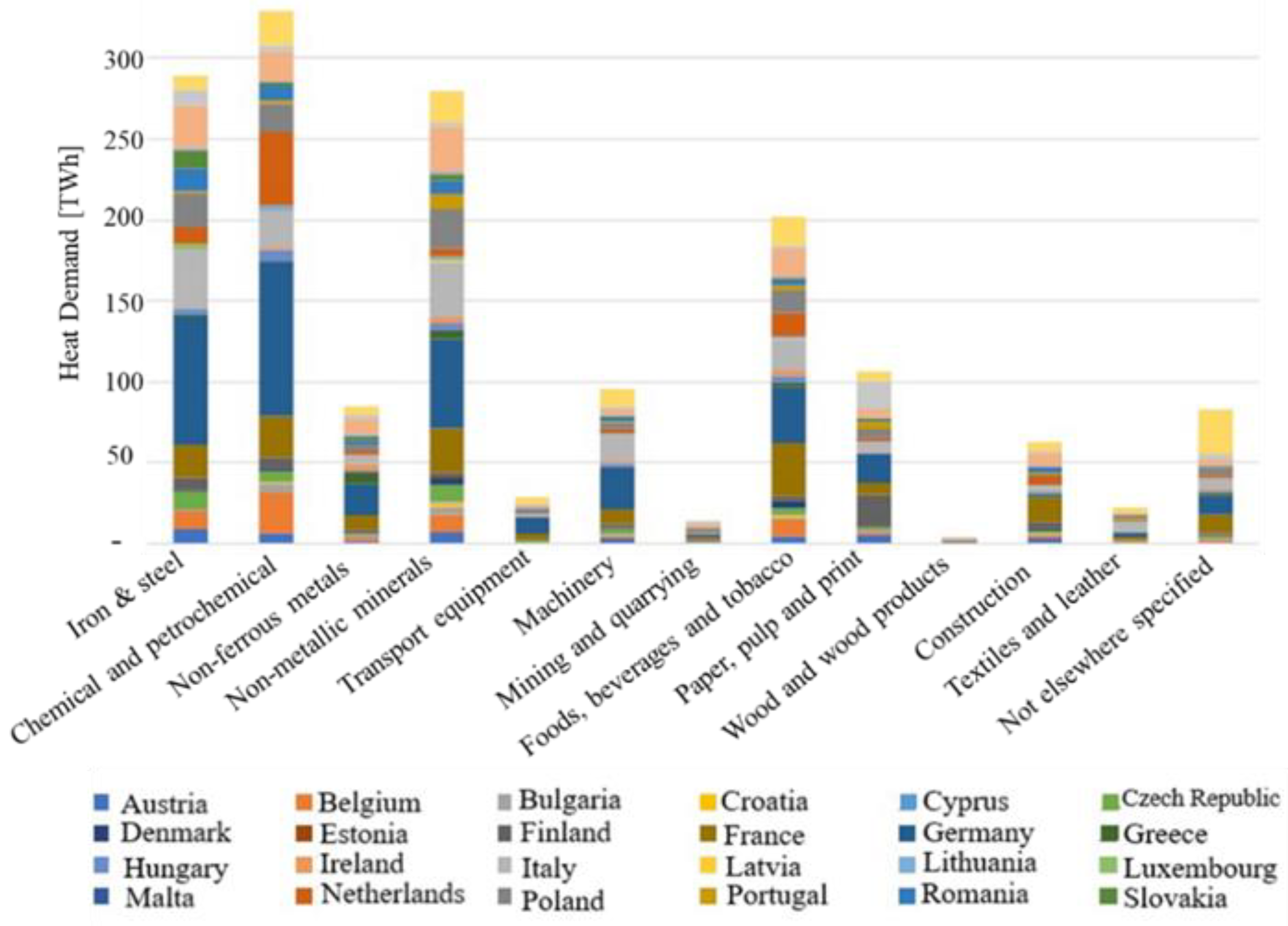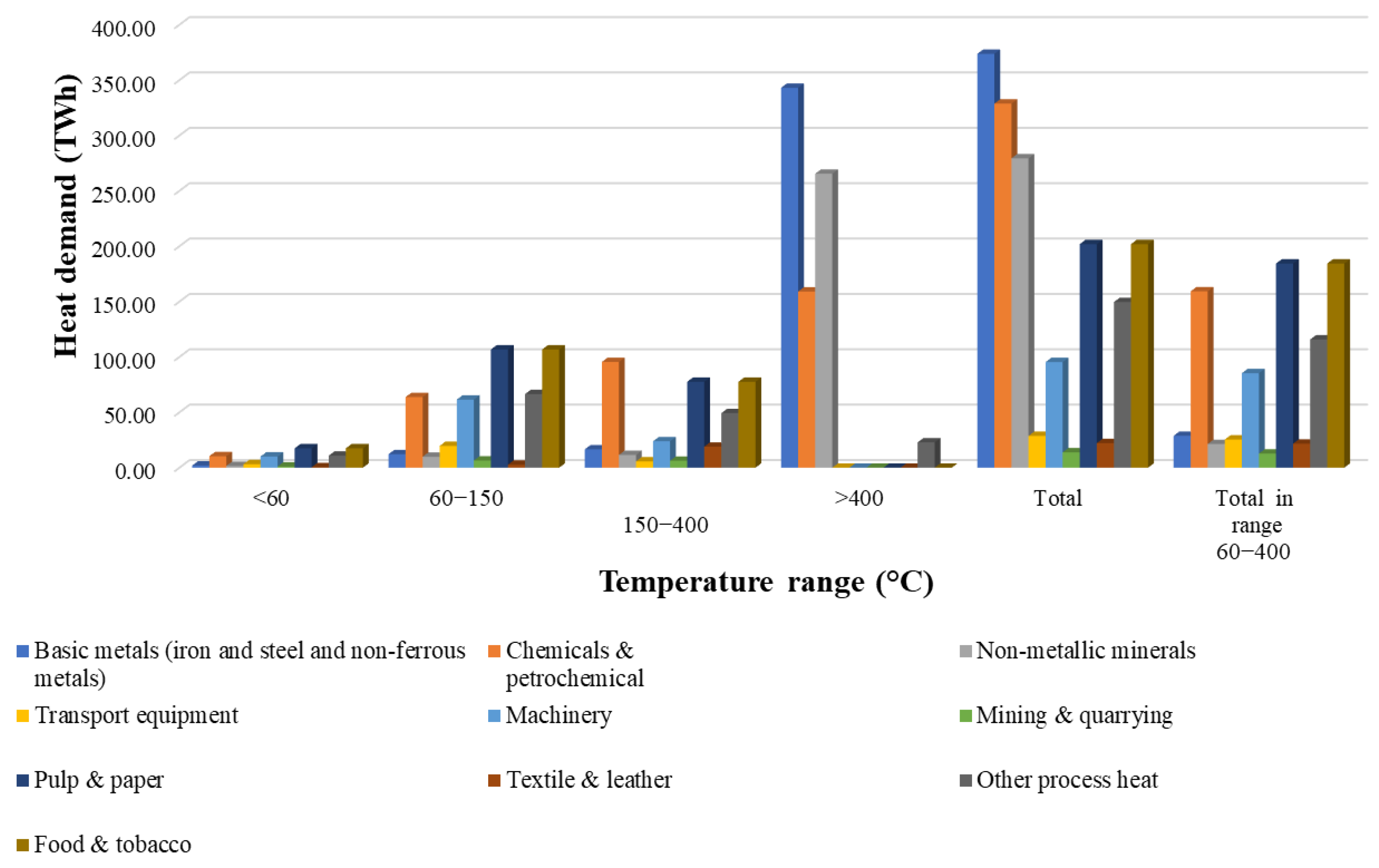Decarbonizing European Industry: A Novel Technology to Heat Supply Using Waste and Renewable Energy
Abstract
:1. Introduction
2. The SUSHEAT Concept
3. Energy Consumption, Heat Demand, and Industrial Processes in the EU
3.1. Final Energy Consumption (FEC)
3.2. Heat Demand
3.3. Heat Demand Based on the Temperature Range for Industrial Sectors in the EU28
3.4. Industrial Processes and Their Required Temperatures
4. The Theoretical Potential (TP) of Implementing the SUSHEAT System across the EU28
5. Waste Heat in the Industries and Heat Pumps
5.1. Waste Heat per Industry in the EU28
5.2. Defining the Heat Demand of Processes and the Potential for Utilizing Waste Heat with Heat Pumps
6. Environmental Advantages of Implementing the SUSHEAT System in the EU 28
7. Conclusions
Author Contributions
Funding
Institutional Review Board Statement
Informed Consent Statement
Data Availability Statement
Acknowledgments
Conflicts of Interest
References
- European Commission. A Clean Planet for all: A European Strategic Long-Term Vision for a Prosperous, Modern, Competitive and Climate Neutral Economy. [COM (2018) 773 final]. European Commission. 2018. Available online: https://eur-lex.europa.eu/legal-content/EN/TXT/?uri=CELEX:52018DC0773 (accessed on 28 November 2018).
- Schlosser, F.; Zysk, S.; Walmsley, T.G.; Kong, L.; Zühlsdorf, B.; Meschede, H. Break-even of high-temperature heat pump integration for milk spray drying. Energy Conv. Manag. 2023, 291, 117304. [Google Scholar] [CrossRef]
- International Energy Agency (IEA). World Energy Outlook 2018. International Energy Agency. 2018. Available online: https://www.iea.org/reports/world-energy-outlook-2018 (accessed on 1 November 2018).
- Statista. Global Greenhouse Gas Emissions by Sector. 2022. Available online: https://www.statista.com/statistics/1325132/ghg-emissions-shares-sector-european-union-eu/ (accessed on 22 May 2024).
- Mohamed, A.R.; Lee, K.T. Energy for sustainable development in Malaysia: Energy policy and alternative energy. Energy policy 2006, 34, 2388–2397. [Google Scholar] [CrossRef]
- Eurostat. Final Energy Consumption n.d. 2020. Available online: https://ec.europa.eu/eurostat/en/web/products-datasets/-/T2020_34 (accessed on 15 September 2020).
- Papapetrou, M.; Kosmadakis, G.; Cipollina, A.; La Commare, U.; Micale, G. Industrial Waste Heat: Estimation of the Technically Available Resource in the EU per Industrial Sector, Temperature Level and Country. Appl. Therm. Eng. 2018, 138, 206–216. [Google Scholar] [CrossRef]
- Markides, C.N. The role of pumped and waste heat technologies in a high-efficiency sustainable energy future for the UK. Appl. Therm. Eng. 2013, 53, 197–209. [Google Scholar] [CrossRef]
- Odyssee-Mure Database. 2017. Available online: http://www.indicators.odyssee-mure.eu/energyefficiency-database.html (accessed on 15 August 2019).
- Eurostat. Final Energy Consumption by Sector. 2022. Available online: https://ec.europa.eu/eurostat/statistics-explained/index.php?title=Final_energy_consumption_in_industry_-_detailed_statistics#cite_note-1 (accessed on 6 June 2024).
- Marina, A.; Spoelstra, S.; Zondag, H.A.; Wemmers, A.K. An estimation of the European industrial heat pump market potential. Renew. Sustain. Energy Rev. 2021, 139, 110545. [Google Scholar] [CrossRef]
- Bamigbetan, O.; Eikevik, T.M.; Nekså, P.; Bantle, M.; Schlemminger, C. Experimental investigation of a prototype R-600 compressor for high temperature heat pump. Energy 2019, 169, 730–738. [Google Scholar] [CrossRef]
- Miró, L.; Brueckner, S.; McKenna, R.; Cabeza, L.F. Methodologies to estimate industrial waste heat potential by transferring key figures: A case study for Spain. Appl. Energy 2016, 169, 866–873. [Google Scholar] [CrossRef]
- Brueckner, S.; Miro, L.; Cabeza, L.F.; Pehnt, M.; Laevemann, E. Methods to estimate the industrial waste heat potential of regions—A categorization and literature review. Renew Sustain Energy Rev. 2014, 38, 164–171. [Google Scholar] [CrossRef]
- Wolf, S.; Lambauer, J.; Blesl, M.; Fahl, U.; Voß, A. Industrial heat pumps in Germany: Potentials, technological development and market barriers. In Proceedings of the ECEEE Industrial Efficiency Conference, Arnhem, The Netherlands, 11–14 September 2012; pp. 543–550. [Google Scholar]
- Campana, F.; Bianchi, M.; Branchini, L.; De Pascale, A.; Peretto, A.; Baresi, M.; Vescovo, R. ORC waste heat recovery in European energy intensive industries: Energy and GHG savings. Energy Convers. Manag. 2013, 76, 244–252. [Google Scholar] [CrossRef]
- Becker, H.; Vuillermoz, A.; Maréchal, F. Heat pump integration in a cheese factory. Appl. Therm. Eng. 2012, 43, 118–127. [Google Scholar] [CrossRef]
- Ntavou, E.; Kosmadakis, G.; Manolakos, D.; Papadakis, G.; Papantonis, D. Experimental testing of a small-scale two stage Organic Rankine Cycle engine operating at low temperature. Energy 2017, 141, 869–879. [Google Scholar] [CrossRef]
- Cao, X.Q.; Yang, W.W.; Zhou, F.; He, Y.L. Performance analysis of different high temperature heat pump systems for low-grade waste heat recovery. Appl. Therm. Eng. 2014, 71, 291–300. [Google Scholar] [CrossRef]
- Institute for Sustainable Process Technology (ISPT). ENCORE—Next Generation Compression Heat Pump. 2020. Available online: https://ispt.eu/projects/encore/ (accessed on 15 May 2023).
- DryFiciency Project. 2020. Available online: https://www.dryficiency.eu/ (accessed on 10 July 2022).
- Arpagaus, C.; Bless, F.; Bertsch, S.; Krummenacher, P.; Flórez-Orrego, D.A.; Pina, E.A.; Rognon, F. Integration of High-Temperature Heat Pumps in Swiss Industrial Processes (HTHP-CH). In Proceedings of the 14th IEA Heat Pump Conference, Chicago, MI, USA, 15–18 May 2023; pp. 1–13. [Google Scholar]
- Khan, U.; Zevenhoven, R.; Stougie, L.; Tveit, T.M. Prediction of stirling-cycle based heat pump performance and environmental footprint with exergy analysis and LCA. Energies 2021, 14, 8478. [Google Scholar] [CrossRef]
- Wolf, S.; Blesl, M. Model-based quantification of the contribution of industrial heat pumps to the European climate change mitigation strategy. In Proceedings of the ECEEE Industrial Efficiency Conference, Arnhem, The Netherlands, 11–14 September 2012; pp. 477–487. [Google Scholar]
- European Commission. Grant Agreement Nº 101103552—SUSHEAT Smart Integration of Waste and Renewable Energy for Sustainable Heat Upgrade in the Industry. European Climate, Infrastructure and Environment Executive Agency, Horizon Europe. 2023. Available online: https://susheat.eu/tes-thermal-energy-storage/ (accessed on 28 March 2023).
- European Commission Energy Balance Sheet—2017 Edition. Available online: https://ec.europa.eu/eurostat/web/products-statistical-books/-/ks-en-17-001 (accessed on 7 August 2020).
- Tannous, H.; Stojceska, V.; Tassou, S.A. The Use of Solar Thermal Heating in SPIRE and Non-SPIRE Industrial Processes. Sustainability 2023, 15, 7807. [Google Scholar] [CrossRef]
- IRENA. Renewable Energy Options for the Industry Sector: Global and Regional Potential until 2030. 2015. Available online: https://www.irena.org/-/media/Files/IRENA/Agency/Publication/2014/Aug/IRENA_RE_Potential_for_Industry_BP_2015.pdf (accessed on 7 August 2020).
- Kosmadakis, G. Estimating the potential of industrial (high-temperature) heat pumps for exploiting waste heat in EU industries. Appl. Therm. Eng. 2019, 156, 287–298. [Google Scholar] [CrossRef]
- Profile of Heating and Cooling Demand in 2015. Available online: https://heatroadmap.eu (accessed on 27 November 2021).
- ASTEP Project. 2023. Available online: https://www.astepproject.eu/about/. (accessed on 19 January 2023).
- Lauterbach, C.; Schmitt, B.; Jordan, U.; Vajen, K. The potential of solar heat for industrial processes in Germany. Renew. Sustain. Energy Rev. 2012, 16, 5121–5130. [Google Scholar] [CrossRef]
- Lillo, I.; Pérez, E.; Moreno, S.; Silva, M. Process heat generation potential from solar concentration technologies in Latin America: The case of Argentina. Energies 2017, 10, 383. [Google Scholar] [CrossRef]
- Ferry, J.; Widyolar, B.; Jiang, L.; Winston, R. Solar thermal wastewater evaporation for brine management and low pressure steam using the XCPC. Appl. Energy 2020, 265, 114746. [Google Scholar] [CrossRef]
- Schmitt, B. Classification of industrial heat consumers for integration of solar heat. Energy Procedia 2016, 91, 650–660. [Google Scholar] [CrossRef]
- Hasanuzzaman, M.; Rahman, M.M.; Öztop, H.F.; Rahim, N.A.; Saidur, R. Effects of Lewis number on heat and mass transfer in a triangular cavity. Int. Commun. J. Heat Mass Transf. 2012, 39, 1213–1219. [Google Scholar] [CrossRef]
- Kim, J.; Lee, M.; Lee, D.; Han, C.; Kim, Y. Energy, economic, and environmental evaluation of a solar-assisted heat pump integrated with photovoltaic thermal modules using low-GWP refrigerants. Energy Convers. Manag. 2023, 293, 117512. [Google Scholar] [CrossRef]
- Plaza, M.; Martinez, I.C.; Gasch, G.M.; Sufrategui, F.T.; Garcia, J.R. A case study of the feasibility of using solar concentrating technologies for manufacturing ceramics. J. Clean. Prod. 2015, 87, 977–991. [Google Scholar] [CrossRef]
- Panayiotou, G.P.; Bianchi, G.; Georgiou, G.; Aresti, L.; Argyrou, M.; Agathokleous, R.; Tsamos, K.M.; Tassou, S.A.; Florides, G.; Kalogirou, S.; et al. Preliminary assessment of waste heat potential in major European industries. Energy Procedia 2017, 123, 335–345. [Google Scholar] [CrossRef]
- European Commission, Energy, Data and Analysis, by Country. 2018. Available online: https://ec.europa.eu/energy/en/dataanalysis/country (accessed on 19 June 2018).
- European Environment Agency. EEA Greenhouse Gas—Data Viewer. 2020. Available online: https://ec.europa.eu/eurostat/databrowser/view/ENV_AIR_GGE/default/table?lang=en (accessed on 18 April 2024).







| Industry | Processes | Required Temperature (°C) | References |
|---|---|---|---|
| Food and Beverages | Frying and baking | Up to 250 | [32] |
| Canned food | Sterilization | 110–120 | [33] |
| Dairy | Drying | 120–180 | [34] |
| Pasteurizing and Sterilization | 60–145 | [32,33] | |
| Paper | Bleach | 130–150 | [33] |
| Water | Evaporating of wastewater | 130–150 | [38] |
| Chemistry | Soaps | 200–260 | [38] |
| Synthetic rubber | 150–200 | ||
| Process heat | 120–180 | [33] | |
| Agricultural products | Drying | 80–200 | [33] |
| Textile | Degreasing | 160–180 | |
| Drying | 100–130 | ||
| Plastics | Drying | 180–200 | [33] |
| Wood products | Pulp preparation | 120–170 | [33] |
| Iron and steel | Heating | 180–220 | [31] |
| Non-ferrous metals | Drying | 60–200 | [38] |
| Industrial Sectors | Theoretical Potential [TWh] | Theoretical Potential over Total Industrial Heat Demand (%) |
|---|---|---|
| Basic metals (iron and steel and non-ferrous metals) | 6.64 | 0.41 |
| Chemicals and chemical products | 38.20 | 2.38 |
| Non-metallic minerals | 4.60 | 0.28 |
| Transport equipment | 2.28 | 0.14 |
| Machinery | 9.56 | 0.59 |
| Mining & quarrying | 2.52 | 0.15 |
| Food & tobacco | 31.04 | 1.94 |
| Pulp & paper | 12.76 | 0.79 |
| Textile & leather | 7.60 | 0.47 |
| Other Process heat | 19.72 | 1.23 |
| Total | 134.92 | 8.38 |
| Type of Industry | Waste Heat Potential (%) |
|---|---|
| Iron and Steel | 11.40 |
| Chemical and Petrochemical | 11.00 |
| Non-ferrous metal industry | 9.59 |
| Non-metallic minerals | 11.40 |
| Food and Tobacco | 8.64 |
| Paper Pulp and Print | 10.56 |
| Wood and Wood Products | 6.00 |
| Textile and Leather | 11.04 |
| Other | 10.38 |
| <150 °C | 15 °C to 200 °C (<200 °C) | |||
|---|---|---|---|---|
| Sector | Process Heat (PJ/y) | Waste Heat (PJ/y) | Process Heat (PJ/y) | Waste Heat (PJ/y) |
| Paper | 228 | 231 | 356 | 231 |
| Chemical | 295 | 320 | 355 | 337 |
| Food | 130 | 96 | 193 | 97 |
| Refinery | 92 | 393 | 219 | 465 |
| Total (Σ) | 745 | 1039 | 1123 | 1130 |
| Company | ||
|---|---|---|
| Mandrekas | Pelagia | |
| City/Country | Corinth/Greece | Bergen/Norway |
| Processes | Pasteurization (Milk/Yoghurt) | Drying (Fishmeal) |
| Heat Sources °C | Cooling of pasteurization products [(1) Milk and (2) Yoghurt]; liquid phase; 75–85 °C, temporal variability | (1) Dryer exhausts; humid air; approx. 60 °C; temporal variability. (2) Condensate streams; liquid water; 90 °C; temporal variability |
| Heat Delivered °C | Process steam; 8 bar; 175 °C | (1) Process steam; 8 bar; 175 °C (2) Hot air to dryers; 200–250 °C (3) Distillation re-boiler; 240 °C |
| Waste heat temperature | 67–80 °C | 70–98 °C |
| Total energy consumption (kWh) | LPG: 1,582,629 | Thermal: 46,487,520 Electricity: 7,583,053 |
Disclaimer/Publisher’s Note: The statements, opinions and data contained in all publications are solely those of the individual author(s) and contributor(s) and not of MDPI and/or the editor(s). MDPI and/or the editor(s) disclaim responsibility for any injury to people or property resulting from any ideas, methods, instructions or products referred to in the content. |
© 2024 by the authors. Licensee MDPI, Basel, Switzerland. This article is an open access article distributed under the terms and conditions of the Creative Commons Attribution (CC BY) license (https://creativecommons.org/licenses/by/4.0/).
Share and Cite
Marcos, J.D.; Golpour, I.; Barbero, R.; Rovira, A. Decarbonizing European Industry: A Novel Technology to Heat Supply Using Waste and Renewable Energy. Appl. Sci. 2024, 14, 8994. https://doi.org/10.3390/app14198994
Marcos JD, Golpour I, Barbero R, Rovira A. Decarbonizing European Industry: A Novel Technology to Heat Supply Using Waste and Renewable Energy. Applied Sciences. 2024; 14(19):8994. https://doi.org/10.3390/app14198994
Chicago/Turabian StyleMarcos, José Daniel, Iman Golpour, Rubén Barbero, and Antonio Rovira. 2024. "Decarbonizing European Industry: A Novel Technology to Heat Supply Using Waste and Renewable Energy" Applied Sciences 14, no. 19: 8994. https://doi.org/10.3390/app14198994








